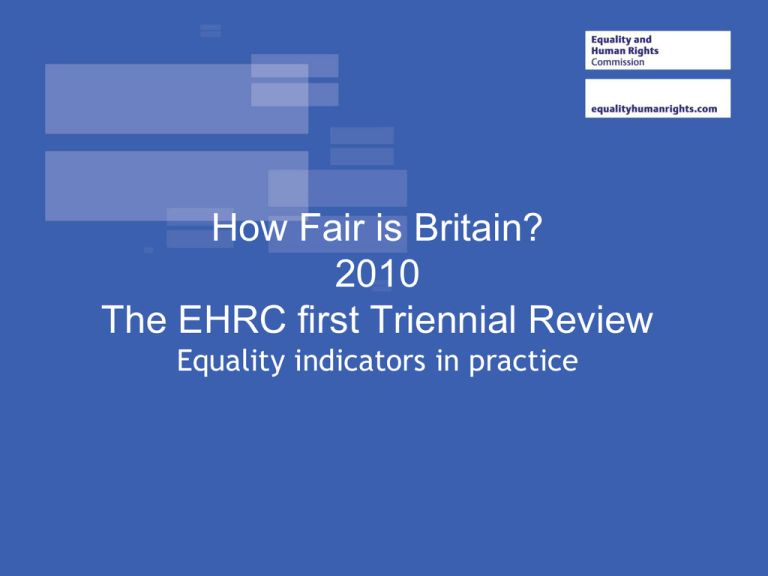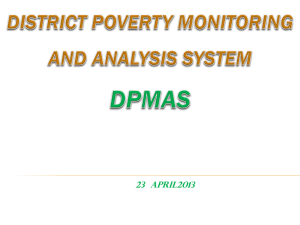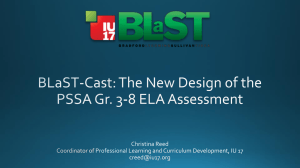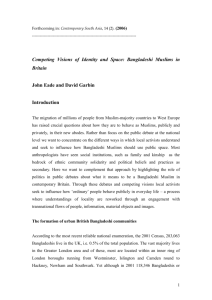slides (Powerpoint format)
advertisement

How Fair is Britain? 2010 The EHRC first Triennial Review Equality indicators in practice The Equality Act (2006) gave the EHRC a statutory duty to: 1. Identify outcomes and indicators that measure society’s progress towards our mandates 2. Monitor progress towards each identified outcome by reference to relevant indicators, producing regular reports. (Section 12 of the Equality Act, 2006). How Fair is Britain? is the first of a 3-year cycle of reports of this progress. The Equality Measurement Framework Structure of the Report Part I – A new landscape Part II – Critical issues facing Britain today 1) 3) 5) 7) 9) Life Physical security Care and support Employment Power and voice 2) 4) 6) 8) Legal security Health Education Standard of living Part III – Findings and challenges Indicators Some key findings (6) Life: •Women on average live for 4 years longer than men •Men and women in the highest socio-economic group can expect to live 7 years longer than those in lower socioeconomic groups •Infants under the age of 1 are more likely to be a victim of homicide than any other age group. •Three times as many men as women commit suicide. •Suicide rates amongst men in Scotland are higher than England Life expectancy; Mortal illness; Suicide; Accidental death; Homicide; Deaths in institutions (7) Legal security: •Black an Asian people are disproportionately affected by Equal treatment by the criminal justice system; Offences reported and brought to justice; Prison numbers and conditions stop-and-search. •Young people with disabilities are less likely to feel fairly treated by the criminal justice system •Ethnic minorities are overly-represented in the custodial system. •Muslim people make up 12% of the prison population Indicators Some key findings (8) Physical security: •1 in 4 women have experienced domestic abuse. •Three quarters of domestic violence offences are repeat offences •Over a quarter of all rapes were committed against children under 16 Crimes against the person; Targeted violence; Fear of crime •Gypsy and Traveller people report having the worst health ‘Poor’ health and limiting outcomes long-term illness or •A quarter of Pakistani and Bangladeshi people report disability; having a LLTI or disability. Poor mental health; •Bangladeshi men are twice as likely to have mental health Living a healthy lifestyle; issues than White men. Dignity and respect in •Evidence suggests the mental health issues are a serious health treatment concern for the both LGB and Transgender populations (9) Health: Indicators Some key findings •Girls routinely outperform boys throughout the educatory Level of development at process age 5; •Gypsy and Traveller students perform worst Permanent exclusion •Disabled children also perform worse than non-disabled from school; Educational children, and are much more likely to be excluded from attainment at age 16; school. Participation in higher •Black and Gypsy and Traveller children are also more education; likely to be excluded than average Adult skills and •Bullying affects many children. LGB and Transgender, and qualifications; disabled are most likely to report being bullied. Victims of Adult learning; Use of the internet bullying do 15% worse at GCSE than average •Black students are less than two-thirds as likely to get a good degree as White students •33% of working age Muslim women have no qualifications, and only 9% have a degree •Being Black and male has potentially greater impact on levels of numeracy than being learning disabled (10) Education: Indicators Some key findings •People with disabilities experience an 11% pay gap •45% of disabled people in their early 20s are NEET (not in Employment; Pay gaps; education, employment, or training) Occupational •1 in 4 Bangladeshi and Pakistani women are employed segregation; •Only 47% of Muslim men, and 24% of Muslim women are Illness and injury at work; employed. 42% of young Muslim people are NEET Discrimination in •Women occupy 77% of administration/secretarial roles, employment and 83% of personal service roles. •Only 6% of engineers and 14% of architects are women. •Women occupy 1 in 3 managerial jobs in Britain (11) Employment: •Wealth of the top 10% of households is almost a hundred times greater than the bottom 10% (£853,000 to £8,800) •1 in 5 people live in households below the 60% of median Wealth; Low pay and low income; income level. This level is 1 in 4 for households with a Housing and disabled person, and 1 in 3 for Bangladeshi-headed neighbourhood quality; households Financial exclusion •Nearly three-quarters of Bangladeshi and half of Black African children grow up in poverty (12) Standard of Living: Indicators Some key findings (13) Care and support: •Lone parents, non-working parents, parents with disabled children, and lower income parents use less childcare, and it is less likely to be formal childcare •1 in 4 women and 1 in 5 men in their 50s are carers. By the time they are 59, women have a 50% chance of providing care •175,000 people under the age of 18 have care responsibilities. 273,000 of people aged 16-74 provide unpaid care despite being sick or disabled themselves. Access to care; Access to childcare; Unpaid care responsibilities •A minority of people under the age of 25 now vote in general and devolved elections •The number of MPs over 50 has increased since 1997. Formal political Religious and ethnic minorities are still underrepresented in participation; Perceptions of influence; Parliament. Political activity; •Less than 25% of MPs are women Taking part in decision•LGB people are more likely to be involved in informal civic making and campaigning or political actions than average (14) Power and voice: organisations Fair Treatment at Work : our employment indicators • Employment rate • NEET rate • Pay gap • Occupational segregation • Illness/injury at work • Perceptions of discrimination And Low pay Intersection: multiple disadvantage Employed full time: • Ethnicity and Gender – 13% Pakistani women – 40% White British Women • Religion and Gender – 46% Black Caribbean Women – 14% Muslim women – 60% Christian women and women with no religion Limitations • • • • Age as a characteristic Inconsistent across indicators Sample sizes Socio-economic/ethnicity/religion characteristics










